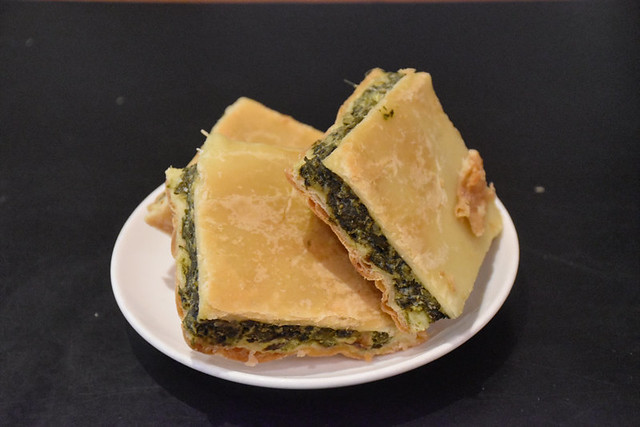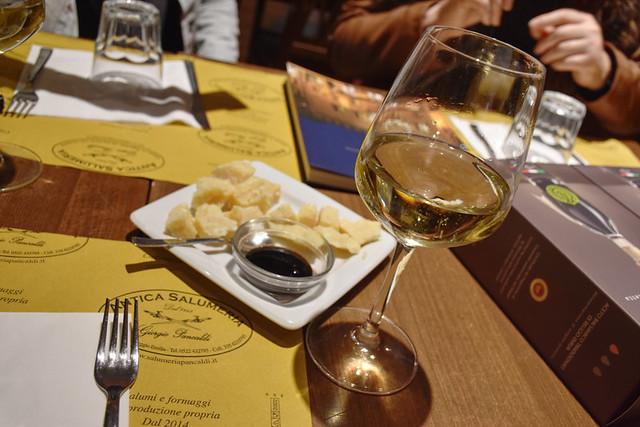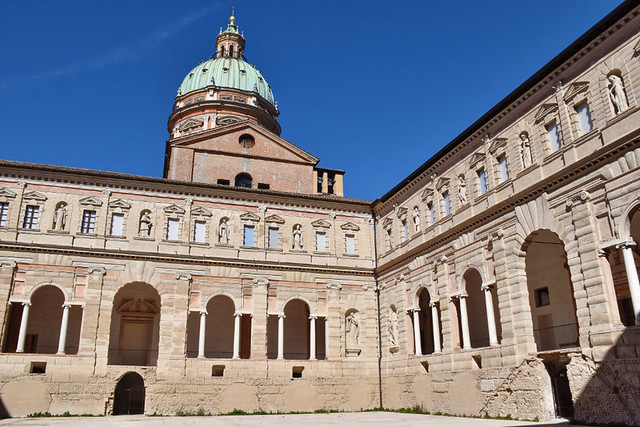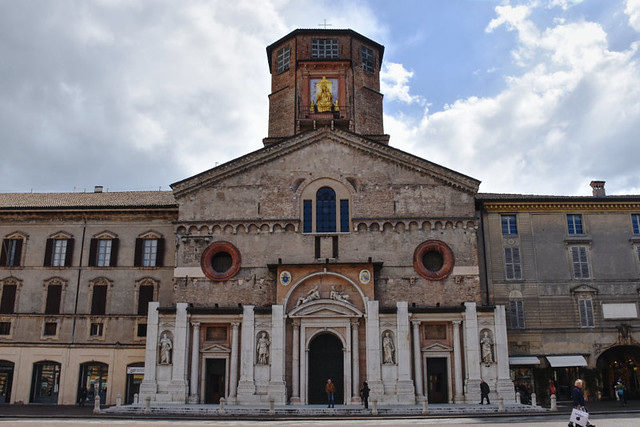We’re in Reggio Emilia.
“Oh look, they have the Co-op here.” I point to a small shopfront painted in the familiar pale blue of the brand. “I wonder if I can use my card.” Jack laughs: “It’s not the Co-op, it’s just Coop.”
“Everyone calls this Piazza Grande,” says Catia, our guide. “But its proper name is Piazza Camillo Prampolini, named after the Socialist reformer who was born here in Reggio Emilia.”
We follow her across the cobbles and past the Cattedrale di Santa Maria Assunta topped by its gold Madonna and Child, heading towards the ornate façade of the Town Hall where two Tricolour flags flutter in the breeze above the colonnaded entrance. Catia stops short of the steps and turns back to talk to us.
“Prampolini was the man who brought socialist principles back to Reggio from Rochdale.”
“Rochdale?!” We chorus. “Rochdale in the UK?” The incredulity in our voices is near-hysteria pitch.
“Yes, Rochdale. Prampolini greatly admired the work of the Rochdale Pioneers, the men who introduced the first Co-operative Society. It was their work that inspired him to advocate the establishment of cooperatives to sell affordable food to those who needed it, and he persuaded the local government to give free medicine to the poor. He brought Socialism from Rochdale to Reggio and then to the rest of Italy.”
I glance at Jack. No words are necessary.
The Rochdale Pioneers
In 1844, 28 working-class men raised funds and set up a small shop on Toad Lane in Rochdale where they sold good quality flour, oatmeal, sugar, and butter at a fair price to the exploited and poverty-stricken workers of the town. They called themselves The Rochdale Equitable Pioneers Society; they became known simply as The Rochdale Pioneers.
In the nineteenth century, poverty was rife in Northern industrial towns like Rochdale. Working in terrible conditions and poorly paid, the working class were further exploited by shop keepers who watered down the milk and added sawdust to the flour. For most workers the cost of sugar and butter were prohibitively high.
Wanting to free the working class from the shackles of charity handouts and give them the means to stand on their own feet economically, The Rochdale Pioneers reasoned that, by acting as a cooperative body, they could afford to buy good quality produce at wholesale prices and could pass that saving on to consumers. Not only would they be providing affordable food for the poor, but they would also be weakening the power of ruthless shop owners to exploit. Every customer became a member and shared in the profits of the shop through dividends.
Initially only open two nights a week, in less than three months the Toad Lane shop was opening five days a week. Today, there are over a billion members in 1,4 million Cooperative Societies worldwide, including in Emilia Romagna.
Reggio Emilia
Sitting at the crossroads of Italy’s main communications arteries of Via Emilia which runs east to west, and Via Roma which runs north to south, Reggio Emilia remains stubbornly below the tourist radar, despite its proximity to, and easy access from neighbours, Modena and Parma.
The lack of summer crowds means it’s easy to stroll Reggio’s streets and piazzas where architectural treasures sit cheek by jowl with pasticcerias selling the delicious erbazzione (chard and parmesan in buttery pastry) which is characteristic of the town, and salumerias brimming with the superb hams, pastas and cheeses of the region.
As well as its erbazzione, Reggio Emilia is home to what many (me included) consider to be the best Parmigiano Reggiano. Produced from the rich, creamy milk of Reggio’s Vache Rosse, or ‘red’ cows, the cheese retains its soft texture and creamy taste longer than that produced from the Freesian, Modenese and brown cows of the rest of the region. The perfect accompaniment to chunks of Parmagiano drizzled in Reggio’s own balsamic vinegar, is a glass of its sparkling spergola, a light fresh wine that gives prosecco a run for its money.
Monumental splendours
In amongst Reggio’s architectural gems is one which, up until recently, even the residents themselves didn’t know anything about – Chiostri di San Pietro. A 16th century monastery which, following the unification of Italy, was transformed into a military barracks with its arches filled in and its gardens and courtyards destroyed. There it remained effectively hidden and forgotten until 2006 when a project to convert it into public use revealed the architectural splendour that lay beneath the bricks.
Two superb cloisters are now restored to a semblance of their original selves; the small one has red and white Verona marble columns which form a porticoed circumference, and frescoed walls which are currently in restoration. The large one is vast, with gabled windows and niches decorated with 17th century statues of Saints from the Benedictine Order. It’s the sort of place that, if it was in Parma or Bologna, would be rammed but here in Reggio Emilia, we have the place to ourselves.
Birthplace of the Italian Tricolour
In the Town Hall is the Sala de Tricolore, the room in which on 7 January 1797, as Napoleon’s troops marched towards them, 110 men from Reggio Emilia, Modena, Ferrara and Bologna met to design a new flag for the impending independence. Adapting the French flag, they replaced the blue with the green of the Italian Legion and created the flag which is still in use today. The Museo del Tricolore outlines the political events that led up to birth of the Tricolour, along with flags of the various forms it has taken from its initial design to the current day.
Arts & parks
Like its neighbours of Parma, Modena and Bologna, Reggio Emilia is home to many priceless works of art, but unlike its neighbours, there are no crowds, queues or large groups led by guides making it difficult to truly appreciate their beauty.
On the façade of the tower of the Cathedral in Piazza Grande (above) is a statue of the Madonna and Child made of gold embossed onto copper plate, a gleaming masterpiece. In the Basilica de San Prospero in the piazza of the same name, is a magnificent Procaccini fresco of The Last Judgement, along with exquisite marquetry on the wooden choir stalls. It was in Reggio Emilia in the mid-1400s that the art of marquetry was born. But the cherry on the art cake is the Basilica della Beata Vergine della Ghiara, the site of a miracle which, during the 17th-century, was decorated by the elite of Emilian artists. The subsequent frescoes, all dedicated to women, represent some of the greatest paintings of the era.
When all that art and architecture has sunk in, head to the green calm of Popolo Park whose monumental fountain was built in 1885 to commemorate the completion of the city’s aqueduct. Here too you’ll find the Monumento dei Concordia – an ornate Roman burial vault discovered in 1929 and placed in a green space so it would be ‘never perishable’ and the surroundings would bring out the best of the monument regardless of season.
It’s the ideal place to sit and enjoy a slice of erbazzione while trying to figure out why Reggio Emilia is as yet, undiscovered.
Getting there:
Trains run frequently between Bologna Central Station and Parma, stopping at Modena and Reggio Emilia along the way. It’s just a 15-minute train journey from Modena to Reggio. If flying into Milan, trains run frequently between Milano Centrale and Parma.
The easiest way to find timetables, book and pay for trains is with the Trenitalia app. Prices vary depending on whether you use the Frecciarossa, high-speed trains, the Intercity, or the RV trains which are slowest and cheapest.











Be the first to comment